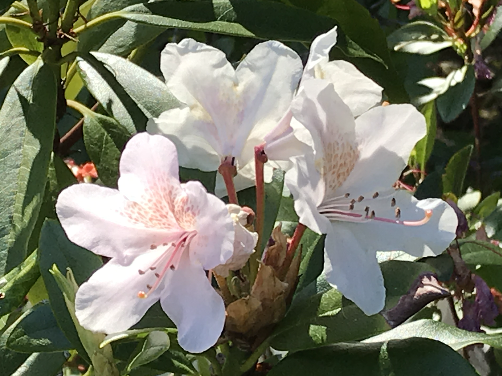One of the plants that makes the coastal northwest beautiful in spring is the evergreen rhododendron. In my microclimate, the majority of our rhodies bloom in May. We do have a couple of early varieties which bloomed in April, but the vast majority of rhododendrons blossom in May each year.
Rhododendrons come in pinks, purples, reds, whites/ivories, oranges and yellows. Our house came complete with a red, a white, and a purple rhodie when we moved in.
Since then, we've added several more, mostly in shades of pink and cream.
This is the rhodie that we can see from our bedroom window. The tight buds are a deep pink, opening to pale pink. Although I started with just this one of this variety, I now have 2 additional clones. (See below how I did that.)
On the other side of the yard is this more salmon-y pink rhodie. The tight blooms are close to a salmon pink crayon in color, opening to a peachy pink blossom.
In our front yard there's a hillside with several different rhododendrons. This white one has yellow centers in each blossom. This particular plant came with the house and is now huge, like a tree with low-growing branches (some touching the soil). These low branches would prove to be beneficial to us. More on that in a bit.
This rhodie is smaller in total growth with smaller leaves and smaller blossoms. This one is a delicate pink. We added this one to the front of the hillside about 15 years ago.
This purple rhodie, like the previous white one, came with the house and property. It is also huge and tree-like, creating a dense screen between our front yard and the neighbor's. And like the white one, it has low-hanging branches which proved to be beneficial.
In actuality, this rhodie is a true red, not dark pink. It came with our house, too, on the hillside. Originally, there were 3 huge rhodies on that hillside, a white, purple, and red.
Although this simply looks like a white rhododendron now, before the blossoms open, they look like a very pale blush pink.
The garden seating area we developed on my birthday in April contains a 3 of these white rhodies. I propagated these from low-hanging branches on the hillside white rhodie mentioned above. The branches were resting on the soil, so I used a simple layering technique to promote rooting on the woody part of the branch.
This article on Gardening Guru explains the simple layering technique. Basically, you skin a very small portion of the branch where it will contact the soil. Then you mound moist soil over this portion of the branch, leaving the green growing tips above the soil. It took our mother plant about a year to develop roots on the branches I layered. I then cut the rooted part of the branch off the mother plant and potted in moist soil and kept in a partially shady spot where I could keep an eye on it and water it as needed. Within two years I had a healthy baby plant (actually 3 healthy baby plants) to transplant into the soil where I wanted this kind of rhododendron.
We've used this technique to propagate a dozen or so rhododendron baby plants to add to our landscape. It's simple, works most of the time, and costs nothing. Now that's a bargain.








Wow, what a beautiful show you have going on at your house. We had some well-established rhododendron at our old house that we liked, so we planted 4 bushes here. One got a fungus and died and the others don't look that good even though it's been several years since we planted them. Disappointing, but even if the bushes aren't that robust, the blooms are still beautiful.
ReplyDeleteI'm sighing with delight. What a beautiful display of color you get to enjoy. I would want to be outside all the time to take it all in.
ReplyDeleteYour rhododendrons are stunning! And you took me down memory lane--my Grandpa had some huge beautiful ones in his yard in Ohio. I've not seen them here in Oklahoma; maybe they don't do well in our climate?
ReplyDelete